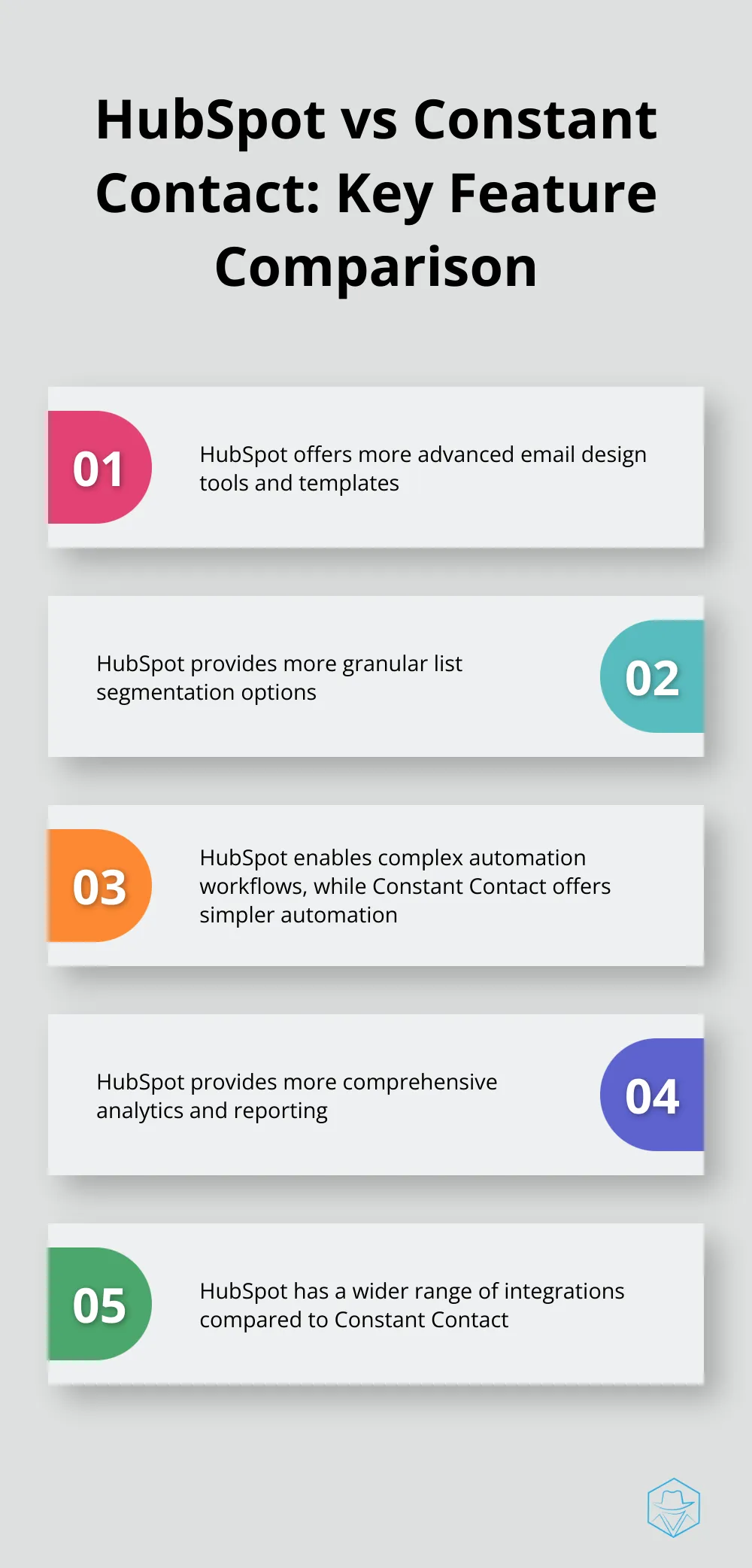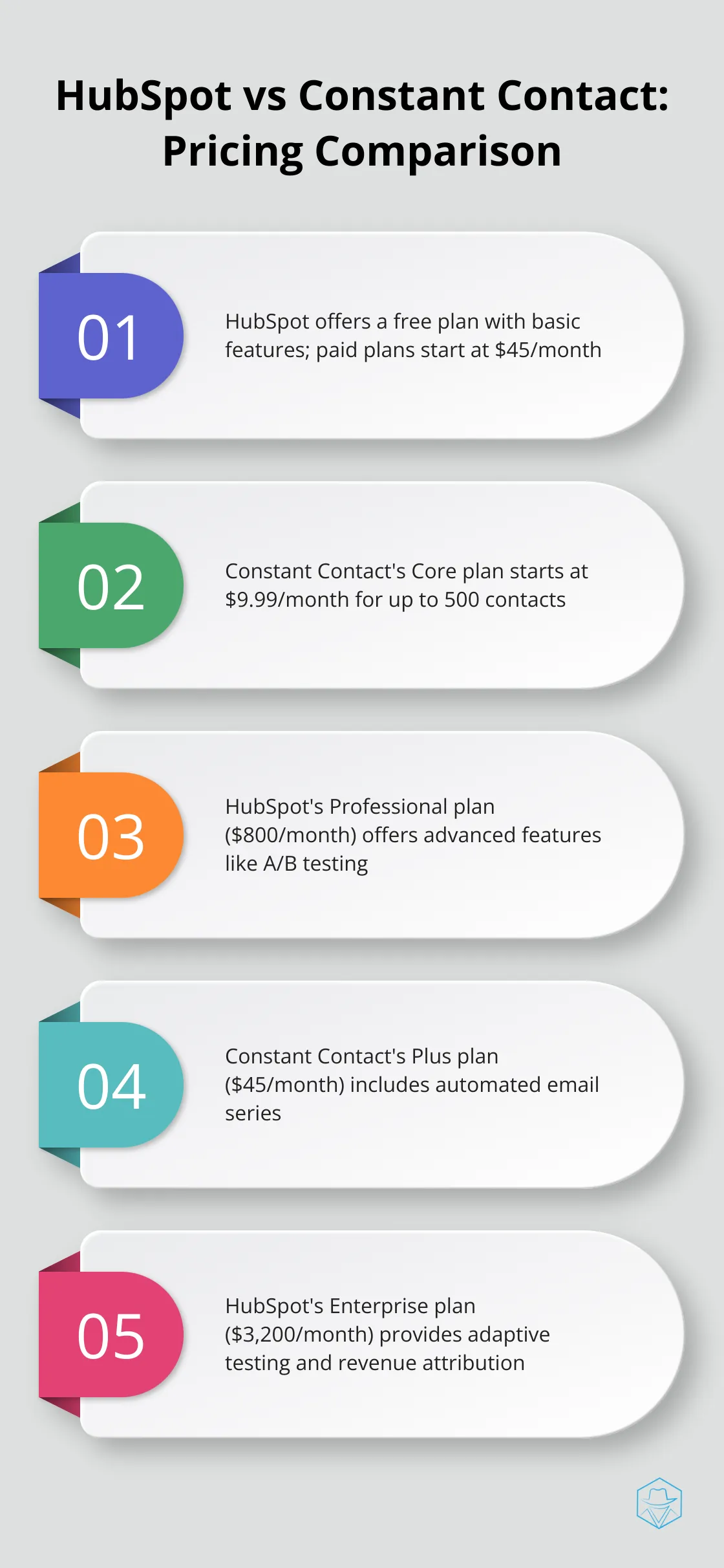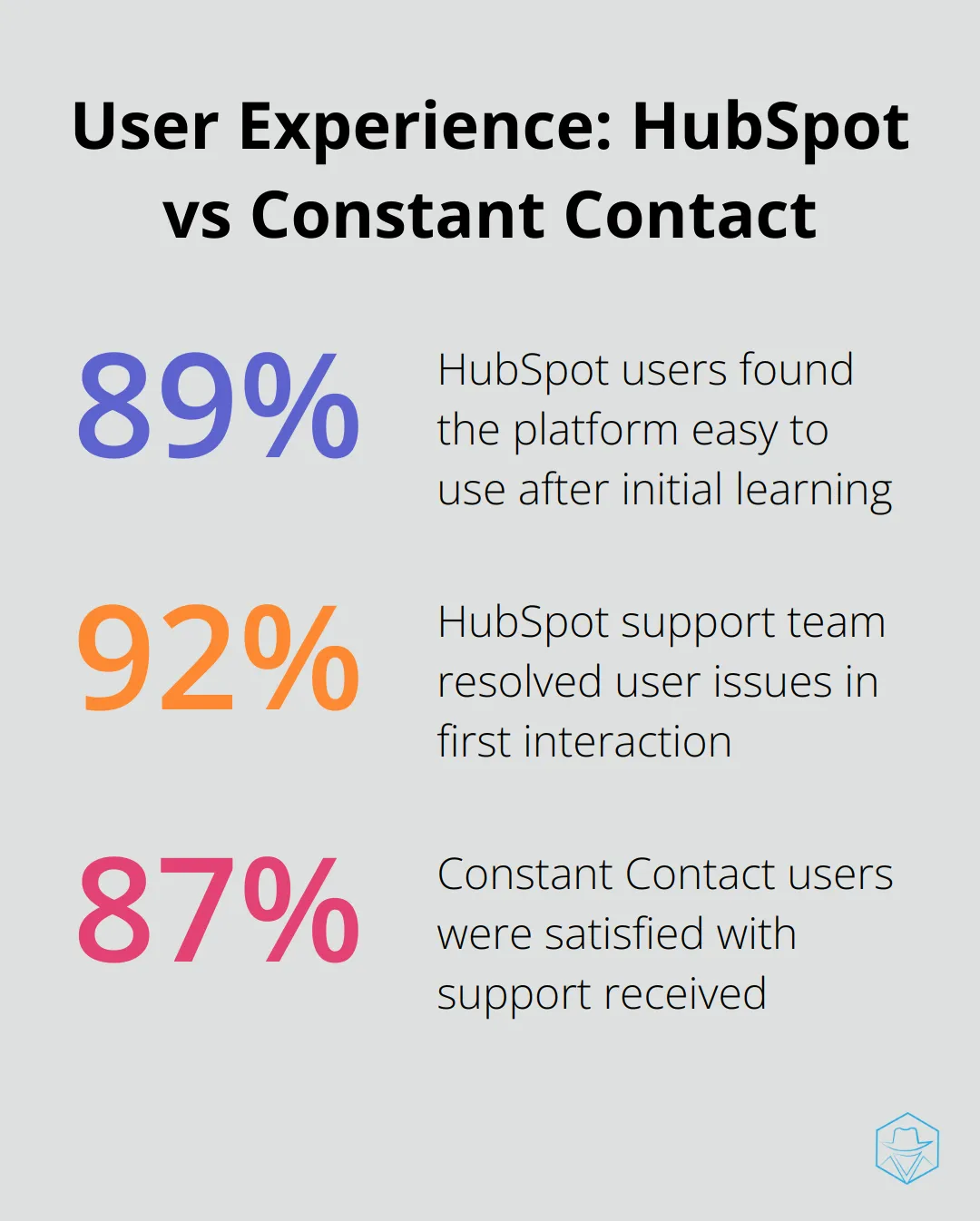HubSpot vs Constant Contact: Email Marketing Face-Off

At Drop Cowboy, we know how crucial it is to choose the right email marketing platform for your business. That’s why we’re diving into the HubSpot vs Constant Contact debate.
These two giants offer unique features and pricing structures that cater to different business needs. In this comparison, we’ll break down their key differences to help you make an informed decision.
Which Platform Offers Better Features?
HubSpot and Constant Contact both offer powerful email marketing tools, but they excel in different areas. Let’s compare their key features to help you decide which platform suits your business needs best.
Email Design and Templates
HubSpot’s drag-and-drop email editor stands out with its extensive library of customizable templates. The intuitive design tools enable even non-designers to create professional-looking emails quickly. Constant Contact also provides a user-friendly email builder, albeit with fewer template options. However, Constant Contact’s templates (known for their simplicity) often appeal to small businesses looking for straightforward design solutions.
List Management and Segmentation
Both platforms excel in list management, but HubSpot takes the lead with its advanced segmentation capabilities. Users can create highly targeted lists based on complex criteria, including behavior and engagement metrics. Constant Contact offers solid segmentation options, though not as granular as HubSpot’s. For many small to medium-sized businesses, Constant Contact’s segmentation features prove more than adequate.
Automation and Analytics
HubSpot’s automation capabilities allow for complex workflows and triggers. Users can set up intricate nurture campaigns that respond to various user actions. Constant Contact’s automation features are more straightforward (which can benefit businesses new to email marketing automation).
In terms of analytics, HubSpot provides deeper insights into campaign performance, including detailed reports on email engagement, customer journeys, and ROI. Constant Contact offers essential analytics that cover open rates, click-through rates, and basic ROI metrics – sufficient for many businesses but not as comprehensive as HubSpot’s offerings.
Integration Capabilities
HubSpot’s extensive marketplace of integrations connects seamlessly with a wide range of tools and platforms, making it a versatile choice for businesses with complex tech stacks. Constant Contact offers fewer integrations but covers most essential tools that small businesses typically use.
Mobile App Functionality
Both platforms offer mobile apps, but HubSpot’s app provides more comprehensive features. Users can manage campaigns, track analytics, and even create emails on the go. Constant Contact’s mobile app focuses primarily on contact management and basic campaign monitoring.
The choice between HubSpot and Constant Contact often depends on the specific needs and technical expertise of the business. For those who require advanced features and in-depth analytics, HubSpot emerges as the clear winner. However, for small businesses seeking a straightforward platform with solid features, Constant Contact remains a strong contender.

Now that we’ve compared the features, let’s examine how these platforms stack up in terms of pricing and value.
How Much Will You Pay for Email Marketing?
HubSpot’s Tiered Pricing Structure
HubSpot offers a free plan with basic email marketing features. Their paid plans start at $45 per month for the Starter package (which includes 1,000 marketing contacts). As your contact list expands, the price increases. The Professional plan starts at $800 per month and offers more advanced features like A/B testing and custom reporting.
For larger enterprises, HubSpot’s Enterprise plan begins at $3,200 per month. This plan includes powerful tools like adaptive testing and revenue attribution reporting that can boost your marketing ROI significantly.
Constant Contact’s Straightforward Approach
Constant Contact takes a simpler approach to pricing. Their Core plan starts at $9.99 per month for up to 500 contacts, which appeals to small businesses or those new to email marketing. The Plus plan, starting at $45 per month, includes additional features like automated email series and dynamic content.
Constant Contact offers a 60-day free trial, allowing users to test the platform thoroughly before committing (this proves particularly useful for small businesses unsure about investing in email marketing).
Cost-Effectiveness Across Business Sizes
Small businesses with limited budgets will find Constant Contact’s lower entry point and straightforward pricing more cost-effective. However, as businesses grow and marketing needs become more complex, HubSpot’s advanced features might justify the higher price tag.
Mid-sized businesses might find the sweet spot with HubSpot’s Starter or Professional plans, depending on their specific needs. These plans offer a good balance of features and affordability.
Large enterprises with complex marketing strategies will likely benefit most from HubSpot’s Enterprise plan, despite the higher cost. The advanced analytics and automation capabilities can drive significant ROI when used effectively.
Hidden Costs and Additional Features
When considering the true cost of an email marketing platform, businesses must look beyond the monthly fee. Factors to consider include:
- Time saved on campaign management
- Potential for increased conversions
- Learning curve and training costs
- Integration capabilities with existing systems
Both HubSpot and Constant Contact offer additional features beyond basic email marketing. HubSpot provides a full CRM suite, while Constant Contact includes event management tools. These extras can add value but may also increase the overall cost.

Alternative Solutions
While HubSpot and Constant Contact dominate the email marketing space, alternatives exist. Drop Cowboy, for instance, offers a unique combination of ringless voicemail and SMS marketing alongside email capabilities, often at a more competitive price point. This multi-channel approach can provide businesses with a more comprehensive communication strategy.
As we move forward, let’s explore how these platforms stack up in terms of user experience and ease of use, factors that can significantly impact the overall value of your chosen email marketing solution.
Which Platform Offers Better Usability?
Interface Navigation
HubSpot’s interface presents a modern look but can overwhelm new users with its extensive feature set. The dashboard provides a comprehensive marketing overview, though finding specific tools might require initial exploration. A 2023 G2 report revealed that 89% of HubSpot users found the platform easy to use after the initial learning curve.
Constant Contact offers a more straightforward interface, immediately accessible to most users. Its simplicity appeals to small businesses and email marketing novices. An Email Tool Tester survey found that 93% of Constant Contact users created and sent their first email campaign within an hour of signing up.
Learning Process
HubSpot’s learning curve proves steeper, but the platform offers extensive educational resources. HubSpot Academy provides free courses and certifications covering platform features and general marketing best practices. In 2023, over 300,000 professionals completed HubSpot Academy courses (indicating the value users find in these resources).
Constant Contact takes a more hands-on approach to user education. The platform includes contextual help and tips throughout the interface, guiding users as they work. They also offer live webinars and video tutorials, which 78% of their users found helpful in a recent customer satisfaction survey.
Customer Support
Both platforms offer customer support, but assistance levels vary. HubSpot’s support proves more comprehensive, especially for higher-tier plans. They provide 24/7 phone and email support, as well as a vibrant community forum for user tips and troubleshooting. In 2023, HubSpot’s support team resolved 92% of user issues within the first interaction.
Constant Contact offers phone, chat, and email support during business hours. While not as extensive as HubSpot’s offerings, their support team boasts quick response times. A 2023 customer survey revealed that 87% of Constant Contact users expressed satisfaction with the support they received.

Mobile Functionality
HubSpot’s mobile app allows users to monitor campaign performance, manage contacts, and create emails from smartphones. According to HubSpot, 62% of their users access the platform via mobile at least once a week.
Constant Contact’s mobile app focuses primarily on contact management and basic campaign monitoring. For small businesses that don’t require extensive mobile functionality, it covers the essentials. A 2023 user survey showed that 54% of Constant Contact users found the mobile app sufficient for their needs.
The choice between HubSpot and Constant Contact often depends on the complexity of your marketing needs and your team’s technical expertise. HubSpot suits businesses requiring advanced features and willing to invest time in learning a comprehensive platform. Constant Contact appeals to those seeking a straightforward, easy-to-use solution.
Final Thoughts
HubSpot and Constant Contact offer robust email marketing solutions for different business needs. HubSpot excels with comprehensive features, advanced automation, and in-depth analytics, ideal for larger businesses or complex marketing strategies. Constant Contact shines in simplicity and ease of use, making it attractive for small businesses or those new to email marketing.
The choice between HubSpot vs Constant Contact depends on your business size, marketing complexity, budget, and growth plans. We recommend evaluating your specific needs, trying free trials, and considering how each platform aligns with your long-term marketing goals. Businesses should also explore alternatives that might offer unique advantages.
Drop Cowboy provides a multi-channel approach combining ringless voicemail, SMS, and email marketing (which can be particularly effective for businesses looking to diversify their communication strategies). This integrated solution allows companies to reach customers through multiple touchpoints, potentially increasing engagement and conversion rates.
blog-dropcowboy-com
Related posts

April 17, 2025
Essential Shopify Apps for Successful Dropshipping
Discover the best Shopify apps for dropshipping to boost efficiency, streamline operations, and enhance customer experience effortlessly.

April 14, 2025
Top Email Marketing Tools for Shopify Store Success
Discover the best email marketing Shopify tools to boost sales, engage customers, and enhance your store’s success seamlessly.

April 21, 2025
Measuring the ROI of Marketing Automation
Analyze the ROI of marketing automation to boost results. Learn effective strategies to assess the value of your automated marketing efforts.

April 24, 2025
Multi-Channel Marketing Automation: Best Practices
Explore best practices in multi-channel marketing automation to enhance your strategy, boost engagement, and drive conversions effectively.

April 17, 2025
Top Review Apps to Build Trust on Your Shopify Store
Boost trust with the best review apps for Shopify. Discover top tools that enhance credibility and drive customer engagement on your online store.

March 8, 2025
Integrating Ringless Voicemail API into Your System
Boost communication with our ringless voicemail API integration guide. Get practical tips and tools for seamless implementation and improved efficiency.